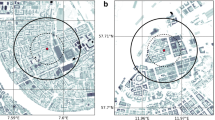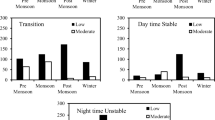Abstract
In air quality practice, observed data are often input to air pollution models to simulate the pollutants dispersion and to estimate their concentration. When the area of interest includes urban sites, observed data collected at urban or suburban stations can be available, and it can happen to use them for estimating surface layer parameters given in input to the models. In such case, roughness sublayer quantities may enter the parameterizations of the turbulence variables as if they were representative of the inertial sublayer, possibly leading to a not appropriate application of the Monin–Obukhov similarity theory. We investigate whether it is possible to derive suitable values of the wind velocity standard deviations for the inertial sublayer using the friction velocity and stability parameter observed in the roughness sublayer, inside a similarity-like analytical function. For this purpose, an analysis of sonic anemometer data sets collected in suburban and urban sites is proposed. The values derived through this approach are compared to actual observations in the inertial sublayer. The transferability of the empirical coefficients estimated for the similarity functions between different sites, characterized by similar or different morphologies, is also addressed. The derived functions proved to be a reasonable approximation of the actual data. This method was found to be feasible and generally reliable, and can be a reference to keep using, in air pollution models, the similarity theory parameterizations when measurements are available only in the roughness sublayer.







Similar content being viewed by others
References
Anfossi D, Oettl D, Degrazia G, Goulart A (2005) An analysis of sonic anemometer observations in low wind speed conditions. Bound Layer Meteor 114:179–203
Bendat JS, Piersol AG (2000) Random data: analysis and measurement procedures, 3rd edn. Wiley, Oxford, p 594
Christen A, Vogt R (2004) Energy and radiation balance of a central European city. Int J Climatol 24(11):1395–1421
Christen A, van Gorsel E, Vogt R (2007) Coherent structures in urban roughness sublayer turbulence. Int J Climatol 27:1955–1968
Christen A, Rotach MW, Vogt R (2009) The budget of turbulent kinetic energy in the urban roughness sublayer. Bound Layer Meteorol 131:193–222
Feigenwinter C, Vogt R, Parlow E (1999) Vertical structure of selected turbulence characteristics above an Urban Canopy. Theor Appl Climatol 62:51–63
Ferrero E, Anfossi D, Richiardone R, Trini Castelli S, Mortarini L, Carretto E, Muraro M, Bande S, Bertoni D (2009) Urban turbulence project—the field experimental campaign. Internal Report ISAC-TO/02-2009, p 37, October 2009, Torino, Italy
Fisher B, Joffre S, Kukkonen J, Piringer M, Rotach MW, Schatzmann M, Eds. (2005) Meteorology applied to urban air pollution problems. Final Report COST Action 715. Demetra LtD Publishers, Bulgaria. ISBN 954-9526-30-5, p 275
Fisher B, Kukkonen J, Piringer M, Rotach MW, Schatzmann M (2006) Meteorology applied to urban air pollution problems: concepts from COST 715. Atmos Chem Phys 6:555–564
Foken T (2006) 50 years of the Monin–Obukhov similarity theory. Bound Layer Meteorol 119:431–447
Fortuniak K, Pawlak W, Siedlecki M (2013) Integral turbulence statistics over a Central European City Centre. Bound Layer Meteorol 146:257–276
Grimmond CSB, Oke TR (1999) Aerodynamic properties of urban areas derived from analysis of surface form. J Appl Meteorol 38:1262–1292
Grimmond CSB, King TS, Roth M, Oke TR (1998) Aerodynamic roughness of urban areas derived from wind observations. Bound Layer Meteorol 89:1–24
Hanna SR (1982) Applications in air pollution modelling. In: Nieuwstadt F, Van Dop H (eds) Atmospheric turbulence and air pollution modelling. Reidel, Dordrecht, pp 275–310
Klipp CJ, Mahrt L (2004) Flux-gradient relationship, self-correlation and intermittency in the stable boundary layer. Q J R Meteorol Soc 130:2087–2103
Luhar AK (2012) Lagrangian particle modeling of dispersion in light winds. In: Lin J, Brunner D, Gerbig C, Stohl A, Luhar A, Webley P et al (eds) Lagrangian modeling of the atmosphere. American Geophysical Union, Washington, DC, pp 37–51. doi:10.1029/2012GM001264
Luhar AK, Venkatram A, Lee SM (2006) On relationships between urban and rural near-surface meteorology for diffusion applications. Atmos Environ 40:6541–6553
Mahrt L (2010) Computing turbulent fluxes near the surface: needed improvements. Agric For Meteorol 150:501–509
McMillen R (1988) An eddy correlation technique with extended applicability to non-simple terrain. Bound Layer Meteorol 43:231–245
Moraes OLL, Acevedo OC, Degrazia GA, Anfossi D, Da Silva R, Anabor V (2005) Surface layer turbulence parameters over a complex terrain. Atmos Environ 39:3103–3112
Mortarini L, Ferrero E, Richiardone R, Falabino S, Anfossi D, Trini Castelli S, Carretto E (2009) Assessment of dispersion parameterizations through wind data measured by three sonic anemometers in an urban canopy. Adv Sci Res 3:91–98
Mortarini L, Ferrero E, Falabino S, Trini Castelli S, Richiardone R, Anfossi D (2013) Low-frequency processes and turbulence structure in a perturbed boundary layer. Q J R Meteorol Soc 139:1059–1072
Pahlow M, Parlange MB, Porte-Agel F (2001) On Monin–Obukhov similarity in the stable atmospheric boundary layer. Bound Layer Meteorol 99:225–248
Princevac M, Venkatram A (2007) Estimating micrometeorological inputs for modeling dispersion in urban areas during stable conditions. Atmos Environ 41:5345–5356
Qian W, Princevac M, Venkatram A (2010) Using temperature fluctuation measurements to estimate meteorological inputs for modelling dispersion during convective conditions in urban areas. Bound Layer Meteorol 135:269–289
Rotach MW (1999) On the influence of the urban roughness sublayer on turbulence and dispersion. Atmos Environ 33:4001–4008
Rotach MW (2001) Simulation of urban-scale dispersion using a lagrangian stochastic dispersion model. Boundary-Layer Meteorol 99:379–410
Rotach MW, Gryning SE, Batchvarova E, Christen A, Vogt R (2004) Pollutant dispersion close to an urban surface—the BUBBLE tracer experiment. Meteorol Atm Phys 87:39–56
Rotach MW, Vogt R, Bernhofer C, Batchvarova E, Christen A, Clappier A, Feddersen B, Gryning SE, Martucci G, Mayer H, Mitev V, Oke TR, Parlow E, Richner H, Roth M, Roulet YA, Ruffieux D, Salmond J, Schatzmann M, Vogt J (2005) BUBBLE—an urban boundary layer meteorology project. Theor Appl Climatol 81:231–261
Roth M (2000) Review of atmospheric turbulence over cities. Q J R Meteorol Soc 126:1941–1990
Trini Castelli S, Falabino S (2013) Parameterization of the wind velocity fluctuation standard deviations in the surface layer in low-wind conditions. Meteorol Atmos Phys 119:91–107
Trini Castelli S, Falabino S, Mortarini L, Ferrero E, Anfossi D, Richiardone R (2011) Analysis of urban boundary-layer turbulence on the basis of an experimental campaign in Turin city—UTP project. In: Proceedings of the 14th international conference on harmonisation within atmospheric dispersion modelling for regulatory purposes, Kos, Greece, 2–6 October 201, pp 414–417
Trini Castelli S, Falabino S, Mortarini L, Ferrero E, Richiardone R, Anfossi D (2014a) Experimental investigation of the surface layer parameters in low wind conditions in a suburban area. Q J R Meteorol Soc 140:2023–2036
Trini Castelli S, Falabino S, Anfossi D (2014b) Effect of the turbulence parameterizations on the simulation of pollutant dispersion with the RMS modelling system. In: Steyn DG, Builtjes P (eds) Air pollution modeling and its application XXII. Springer, Berlin, pp 529–534
Venkatram A, Princevac M (2008) Using measurements in urban areas to estimate turbulent velocities for modelling dispersion. Atmos Environ 42:3833–3841
Vickers D, Mahrt L (2003) The cospectral gap and turbulent flux calculations. J Atmos Oc Tech 20:660–672
Wilson JD (2008) Monin–Obukhov functions for standard deviations of velocity. Bound Layer Meteorol 129:353–369
Acknowledgments
We are very grateful to Prof. Mathias Rotach and Prof. Andreas Christen for providing us the BUBBLE data sets used in this work and for their precious support.
Author information
Authors and Affiliations
Corresponding author
Additional information
Responsible Editor: C. Simmer.
Rights and permissions
About this article
Cite this article
Falabino, S., Trini Castelli, S. Estimating wind velocity standard deviation values in the inertial sublayer from observations in the roughness sublayer. Meteorol Atmos Phys 129, 83–98 (2017). https://doi.org/10.1007/s00703-016-0457-x
Received:
Accepted:
Published:
Issue Date:
DOI: https://doi.org/10.1007/s00703-016-0457-x




